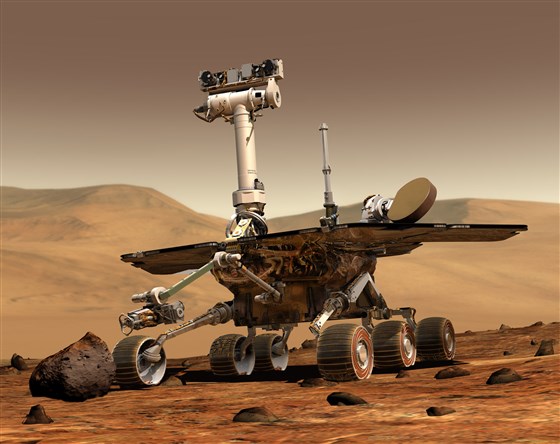After falling silent eight months ago during a severe dust storm that swept across the Red Planet, NASA’s Mars Opportunity rover has been officially declared dead.
NASA made the announcement Wednesday during an emotional media briefing at the space agency’s Jet Propulsion Laboratory in Pasadena, California. The agency said it had ended its efforts to communicate with Opportunity after sending more than 1,000 radio signals its way, including some just last night.
“I was there yesterday and I was there with the team as these commands went out into the deep sky, and I learned this morning that we had not heard back,” Thomas Zurbuchen, associate administrator of NASA’s Science Mission Directorate, said in the briefing. “Opportunity remains silent.”
John Callas, project manager for the Opportunity mission, said last year’s dust storm was so intense that it blackened the sky, keeping sunlight from reaching Opportunity’s solar panels and starving the spacecraft of energy. Callas reminisced about the mission’s early days and spoke fondly about “bonding” with the rover as it was being assembled at the Jet Propulsion Lab.
“Even though it’s a machine and we’re saying goodbye, it’s still very hard and very poignant,” he said in the briefing.
Opportunity touched down on Mars on Jan. 25, 2004. During the 15 years it spent trundling across the planet, the rover provided evidence confirming that water once flowed on the Martian surface — suggesting that Mars might once have been habitable — and beamed back a series of stark photos of the barren landscape.
Opportunity and a twin rover, Spirit, which reached Mars on Jan. 4, 2004, were designed to operate for only 90 days. But both rovers far outlived their planned missions. Spirit got stuck in Martian sand in 2009, and NASA ended its mission in 2011 after losing contact with the rover.
The rover duo leaves behind an important legacy, in particular showing the value of equipping rovers with tools and instruments that let them act as roving geologists, said Jennifer Trosper, a systems engineer for NASA’s upcoming Mars 2020 mission, which next year will send a new rover to search for evidence of past life on the Red Planet.
“We took everything that we needed, we put it on wheels and we made a geologist that could go investigate the things the science team was interested in,” Trosper said.
Both Spirit and Opportunity were stepping stones for the planned Mars 2020 mission, influencing decisions about where the new rover should land and what it should investigate.
“These two rovers really did change the way we think about doing planetary science on the surface of other planets,” said Lori Glaze, acting director of NASA’s Planetary Science Division.
Before Spirit and Opportunity, NASA sent the Pathfinder lander and Sojourner rover to Mars on a mission to conduct chemical and atmospheric experiments on the Red Planet. Pathfinder and Sojourner landed on Mars in July 1997, and the rover spent 83 days exploring the Martian surface.
NASA now has one active rover on Mars. The car-sized Curiosity rover arrived in August 2012 and has driven more than 12 miles so far.








